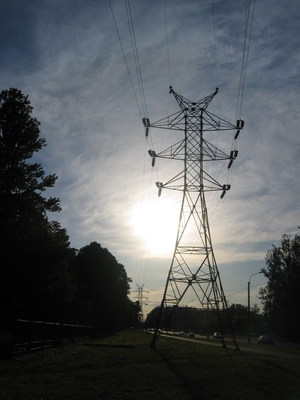The Baltimore Sun reported recently that in June 2008 BGE’s residential electric rates in Maryland will increase by 5.5%. This will make rates 82% higher than in May 2006. Relief is unlikely anytime soon. What’s behind these increases?
Demand vs. supply
The simplest economic explanation would be an increase in demand for electric power beyond the increase in supply. However, as reported in a Department of Energy (DOE) report, Maryland electric consumption peaked in 2003 at 76,069 million kWh and gradually decreased to 69,230 million kWh in 2006.
The DOE report also shows that during that time total generation followed a similar trend, with a 2003 peak total generation of 52,244 million kWh gradually decreasing to 48,957 million kWh in 2006. The numbers prove that during the past several years demand has dropped by 9% from its 2003 peak. In-state generation has also dropped during that time, but more slowly.
In 2003, Maryland generation capacity had its last major increase, of 5%. That year the fraction of electricity imported by Maryland from neighboring states decreased from just under 35% to 31%. Since then, the fraction has varied between 28% and 30%. The balance between supply and demand has thus not shifted in a way that would explain the cost increase.
Increasing price of fuels
DOE data show that from 1999 to 2006 the cost of natural gas shot up over 170%. At the same time, prices of heating oil in Maryland went up 115%, and petroleum prices more than tripled.
Since deregulation forced utilities to divest power plants, BGE’s electricity is supplied by Constellation Energy. DOE data show that about 90% of Constellation Energy’s capacity in MD is from coal-fired plants. With coal prices up only 39% since deregulation, clearly Constellation’s production costs have not been the main driver of the increase in rates
Effects of deregulation
In 1999 Maryland deregulated its power industry. The notion was that opening the field to competition would push prices down. If prices increased, more plants would be built to cash in on the higher profit potential. The increased supply would then control pricing pressures. The hoped-for reduction in electric rates has not materialized. With the difficulty, expense, and risks involved, few plants have been built since deregulation.
From 1999 to 2006 electric rates were artificially capped. Once the cap expired prices rocketed to match the rest of the energy market. This provides a first hint at to the secret behind price increases.
In a free market prices go to what the market will bear, keeping consumption in check
Constellation Energy and BGE have done nothing nefarious. With the great increases in prices of fuels used by the competition, market prices have gone up. Constellation is simply reaping the benefit of having been lucky or smart in their fuel choice.
The Washington Post has reported that some have started promoting re-regulation of the energy industry to force the price genie back into the bottle. Aside from the political difficulties inherent in such a course, it is not clear this is the right thing to do.
When prices are kept artificially low, there is no inducement to become more efficient. If prices were forced back to what they were 2 years ago, the Maryland consumer, both residential and commercial, would continue to demand more electricity than Maryland plants produce.
This is why federal rules force a capacity surcharge when local generation capacity does not cover demand. With the 30% electricity DOE data show is imported by Maryland, these rules are the immediate cause for the impending 5.5% rate increase.
What can you do?
According to the DOE, Maryland’s current total maximum generation capacity is 12,500 megawatts. To avoid the capacity surcharge, Maryland would need to increase capacity, reduce consumption, or a combination, totaling 5300 megawatts.
However, even an immediate start on large power plants would not bring increased capacity online for many years. As a result, annual increases in BGE’s electric rates are likely to be with us for the foreseeable future.
Even then, prices would merely revert to market levels. To reduce our cost of electricity, consumers should look to increased efficiency to reduce the power we consume.
Another path is renewable energy – solar, wind, tide, or geothermal. Wind, tide, and geothermal systems are simply not feasible to put on a roof or in a back yard. This leaves only solar as an option to the individual citizen.
Unfortunately, at this point the prices of electricity and of home solar systems make it financially unfeasible to replace grid electricity completely with home solar power systems. Only a significant increase in government incentives would convince most homeowners to take the plunge and install home based solar power systems.
These incentives would need to become higher even than the $10,000 available in some jurisdictions such as Howard County, MD. In Maryland, replacing 10,000 kWh/year of grid power with solar requires an 8 kW system, costing about $60,000 to install. Very few homeowners would be willing or able to spend the $50,000 remaining cost after incentives.
The bottom line
Regardless the cause of rapid electric rate increases the public outcry is very human. With annual inflation of about 3%, electricity has become over 70% more expensive in Maryland relative to other costs in just the last 2 years.
One hopes that as time goes by and technology improves, solar systems will become more efficient and less costly. In 10 or 20 years, the financial equation may become very different. For now, you can only replace old appliances with more energy efficient ones, replace incandescent bulbs with compact fluorescents, and pray for fusion reactors to become a reality.








